Are you confused and overwhelmed by the infinite choice (and price range) of online design bootcamps, courses, and programs?
I’ll make it simple.
Here's How to Become a Confident Product Designer Without an Expensive Bootcamp
But first, can I tell you a true story about how my friend Bex got ripped off by a bootcamp?
I hope it doesn’t happen to you.
Here’s what happened...
Bex studied business in school and ended up working in ministry. She’ is a painter and illustrator, and found that she enjoyed that work more than the business and administrative work she was doing.
She decided to explore a different career path and had a hunch Product Design was the right mix of visual design and solving problems that would be fulfilling. She tried building a portfolio on her own but often got distracted, lost and overwhelmed.
Seriously committed, Bex did her research and decided to join a well-reviewed bootcamp and paid them $14,000. She moved across the country from Florida to San Francisco and spent months going to their weekly lessons, working out of their co-working space, and collaborating with other bootcamp students.
OK — so far so good, but here’s what made me mad.
During the bootcamp, my wife and I were talking regularly with her. She was confused. She didn’t understand how everything fit together. The students in the bootcamp were competitive, and difficult to work with. When they worked on projects, it felt like the blind leading the blind because the folks that worked there didn’t have time to help every student. She would call me in a hushed voice from the bootcamp and ask legit questions and express real, valid frustrations.
At the end of the bootcamp she applied for jobs and was rejected, but couldn’t understand why. She did everything right and what they said to do.
Now, here’s the harsh reality. Although almost all bootcamps promise a job at the end, there is no way to guarantee it. The reality is that many people are not fit to be a Product Designer. It’s an odd set of skills that companies are willing to pay $80,000 in starting salary for.
Bootcamps aren’t in the business of filtering. If someone has $14,000 and is willing to pay them, they welcome them.
But here’s the thing. Bex is really good at Product Design. I could see it. But.. the bootcamp failed to bring it out of her.
After her bad bootcamp experience, I worked with her, taught her my method and coached her. We worked through real projects, and she put in the hours . She asked really good questions, took notes, listened, and did the work.
Fast-forward to today, Bex is working at a well-funded startup as a full-time Product Designer and earning a six-figure salary. She is steadily building a portfolio full of examples of products that have been built, launch and show meaningful outcomes. She’s more confident than ever before.
Do you want something similar?
I want that for you, too.
So what would happen if you stopped looking for one course, one book, one method? ...and instead just did the work? While others spend $14,000 to get a few videos and 10 weeks of Zoom meetings to produce a formulaic, copycat looking portfolio... you can take a different path.
Hi, Xander here 👋
Imagine you’ve decided to go all in.
You’ve made the leap. You now have a clear path.
You finally understand what it takes to become a Product Designer and the steps to get there. You’re not distracted by other training programs. No more researching bootcamps, because you finally found an affordable training you believe in. You’re not constantly reading and re-reading articles. You have a clear path you are walking down, slowly and confidently.
Everyday you know what to work on to make progress towards your goal. When someone asks how it’s going, you can confidently explain the path you’re on.
You talk to a bootcamp grad. They share the curriculum and how much “stuff” they “learned.”It feels like they have been plugging knowledge gaps, but each plug they fill another one opens up. You talk about design as something much simpler.
Other designers talk about complex research methods, syntax, academic research. You smile inside because you know it’s much simpler and you have the secret.
You’ve learned to enjoy the practice and repetition of only the most important tasks. You have clarity and confidence when talking about how to solve a problem.
Imagine your job title on Linkedin says “Product Designer.” You’re working alongside engineers and product managers to build software that people use everyday. You can hold the app in your hand, and point to the parts that you designed. You can watch other people use it. You’re well-paid for your time, but it doesn’t feel like work. You’re learning and growing and energized each day...
That’s what I want for every one of my students.
Is that what you want?
Listen — I've been there
I got lucky and landed a job as a UI designer at a tech company over a decade ago. They hired me even though I had studied art. There were so few designers in tech at the time, it was common to hire folks with little experience.
When I first started working as a UI designer, I was scared.
I thought somebody would figure out that I didn’t actually know what I was doing.
Everyday I felt like I was faking it and I wasn’t a “real” designer. I picked up tricks here and there, read articles online, but it wasn’t enough. I always felt like I didn’t get the big picture.
Maybe you’re like me. I didn’t go to school for UI, UX or Product Design... I studied Art!
But then one day at my job, everything changed.
I met the designers at Google Ventures. They finally put a method to my daily-work scramble.
If you don’t know, Jake Knapp and the Google Ventures team worked with top startups using a “Design Sprint” process to do research, brainstorm, build prototypes, and test with users… all in 5 days.
After doing a 5 day Design Sprint with them, I loved it. It finally felt like the design process made sense to me. It put templates and checklists in place as a process that just flows. With that process it felt like I did more design work in that week than in the last month sitting at my desk.
aaaand... there’s the problem.
When I went back to my desk, I was feeling lost again. I found myself thinking... “How do I do more than just design what ‘feels right’ and ‘looks good?’”
I saw other designers struggling, too. I met developers and entrepreneurs who wanted to use “design thinking” to build something people want, but didn’t know how. Design thinking was confusing to me. It seemed more like consulting than designing. I didn’t understand how it would help me design better user interfaces or user experiences.
If you search you will find that the tools, framework, and process to do consistent, thoughtful, innovative design work is out there, but sadly, for many aspiring product designers this means you have to duct tape them together and learn on your own.
That’s why I created Product Design Pro for you.
It’s what I wish I had when I started…
Today, I’m here to share everything I learned with you, and help you on your journey to become a product designer.
I’ve learned from Silicon Valley’s best and brightest designers while working with the team at Google Ventures, Google Maps, Gmail, my own startup, and consulting for dozens of other startups.
From experience, I’ve built a step-by-step course on how to transform into a designer. This is what I wish I had when I started.. all the tools, frameworks and process to do great design work.
Learning on your own is hard, I know because I’ve been there too. It’s difficult to stay motivated. There’s no one holding you accountable. Bouncing around from Medium article to design textbook feels really disjointed, and doesn’t give you the big picture.
I laughed when one of my students described it this way…"Been reading lots of O'Reilly books.. they’re okay, but they give examples from 2008 which definitely aren’t helpful.”
I’m giving you a literal over-the-shoulder sneak peek at my exact design process as I design apps. I will take you by the hand and show you the principles and strategies needed to build a rock-solid design foundation, so that you can confidently do design work.
…plus I’ll provide the coaching and support system that others don’t.
Easy to follow lessons? Check.
Step-by-step checklists? Check.
Built-in accountability? Check.
This apprenticeship is grounded in a proven process pioneered by design mentors of mine at Google Ventures. Its broken down into simple lessons that walk you through each of the 5 stages of solving a business problem using design. Its traditionally taught as a five-day process, but I believe it should be the foundation of your day-to-day work. The process is refined and brought to life with my own real-life experience designing at my own startup and my four years at Google.
Each lesson comes with easy-to-follow checklists that you can have with you at all times to reference and implement what you’ve learned.
- No guesswork
- No wasting time reading blog posts
- No trudging through boring, academic textbooks
Transform into a designer by growing your toolkit, practicing the best design process, and leveling up your confidence.
I'll Be Your Personal Coach & Mentor
I’m a digital Product Designer and Google Ventures Design Sprint facilitator based in Silicon Valley. I have 10 years of experience in tech, from founding a startup to designing and launching new products for millions of users at Google.
Today, my main job is to help companies align teams and build better products faster using Design Sprints. I was trained by the inventor of the method Jake Knapp. I work with companies like Twitter, Adobe, Fitbit, Stanford & Cisco. Before consulting, I worked at Google as a designer for four years on the Google Maps and the Gmail team.
I currently run a small design and product consultancy (Palo Alto Design Company) and live with my wife and two sons in Palo Alto, California.
Product Design Pro was developed over the last 5 years as a way to help underrepresented folks get into tech. I want to pass on what I’ve learned to help and grow the next generation of people designing products that impact the world.
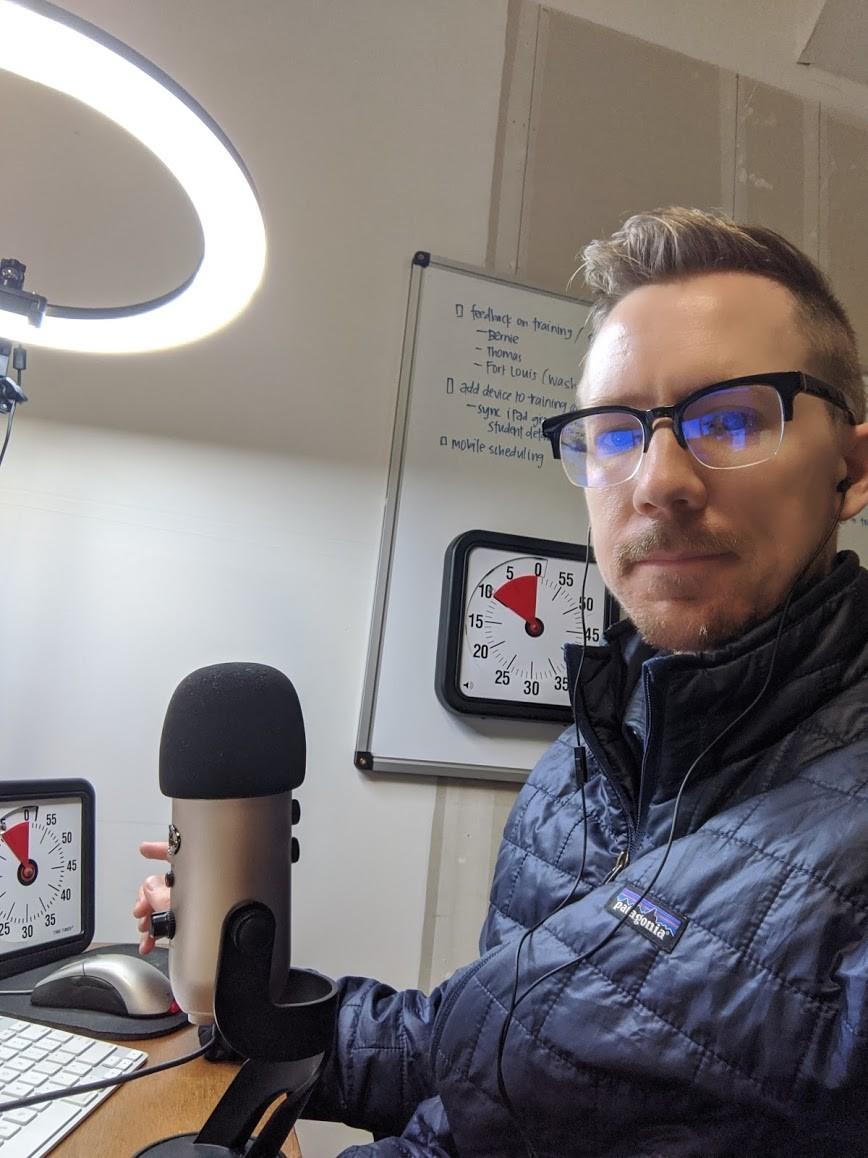
Successful Students
Students have used my training to get promoted, get a new job, build a portfolio, transition within their company, and do better work at their current job.
“My goal has always been to get into those dream jobs or have those opportunities, but I knew I couldn't get there on my own (and this is not being hyperbolic, I truly believe this).
I knew I had to fix some holes. And before I never really knew what those holes could be, only that the could be exposed when I couldn't back out and had to explain myself on how do I solve real problems?
I studied and I worked at your process every single day until it became second nature. Then I started interviewing and reaching out to the large tech companies and it paid off. I've gotten an offer from Google!”
Hear how Hillary transitioned from "do-it-all" marketing designer to a Senior UX designer at athenahealth. Hear how her Product Design Pro project landed her dream job.
Product Design Pro is a Remote Product Design Apprenticeship Training
Learn Product Design directly from me, a skilled practitioner
Fix your broken process and fill in the gaps in your product design knowledge Finally, a complete end-to-end understanding of how to design an app. This training will hammer home the big picture so you can start to fill in each gap in your knowledge and practice.
Experience how a successful, professional Google product designer works Go behind-the-scenes of products I've designed where I walk you through the way I think and talk and design. It's like sitting next to me at work, which is the best way to learn.
Build your confidence and talk like a designer You will have a language that is comfortable for you to use (not robotic) and will be familiar to interviewers.
Develop a rock-solid repeatable process to design apps and software The core of this process is the Google Ventures sprint process. It's time-tested and rock-solid. You will walk away with a clear understanding of how to apply this process to designing successful software.
"Before working with Xander, I was a UX/UI designer with a focus on visual design. Through his program, I learned about and practiced actual step-by-step methods to designing products and came away with a strong, holistic view of the process.
From discovery and research through to rapid sketching, prototyping, and testing, going through the whole product design cycle with Xander gave me an opportunity to learn specific skills that I didn't get to develop much at my then day job.
Currently I'm a senior mobile product designer, and everything I learned then is still incredibly relevant today."
Here’s Exactly What You’ll Find Inside

STAGE 0
Product Design 101
- The one thing every company is on a quest to answer and how you can help guide that process using design techniques
- The sentence that explains Product Design in a nutshell
- An overview of the design “Process” (how you work)
- An overview of all design “Deliverables” (what you make)
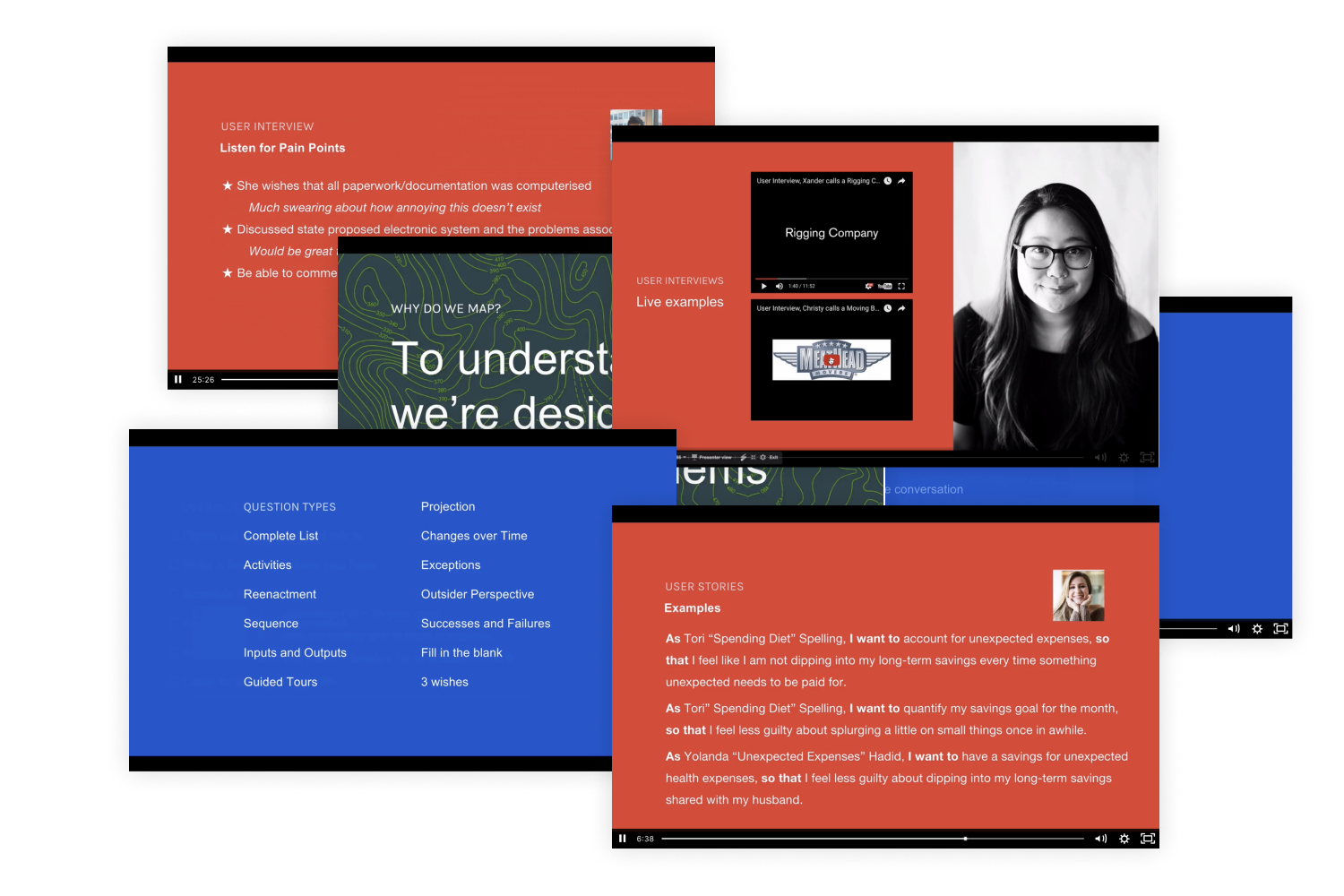
STAGE 1
Map
How to deeply understand people to design a product they love
You will learn..
- How to uncover painful problems that your users have that they will pay money for
- Why the unsexiest work of designers is the most critical
- How to avoid the pitfall most designers on Dribbble fall into
- All my tips on working with a team to understand your users together
- 7 exercises to run through with your team to discover deep insights about your customers
- Google’s “secret phrase” that top innovators use in almost every design meeting
You will make...
- Design Brief
- User interview synthesis
- User stories
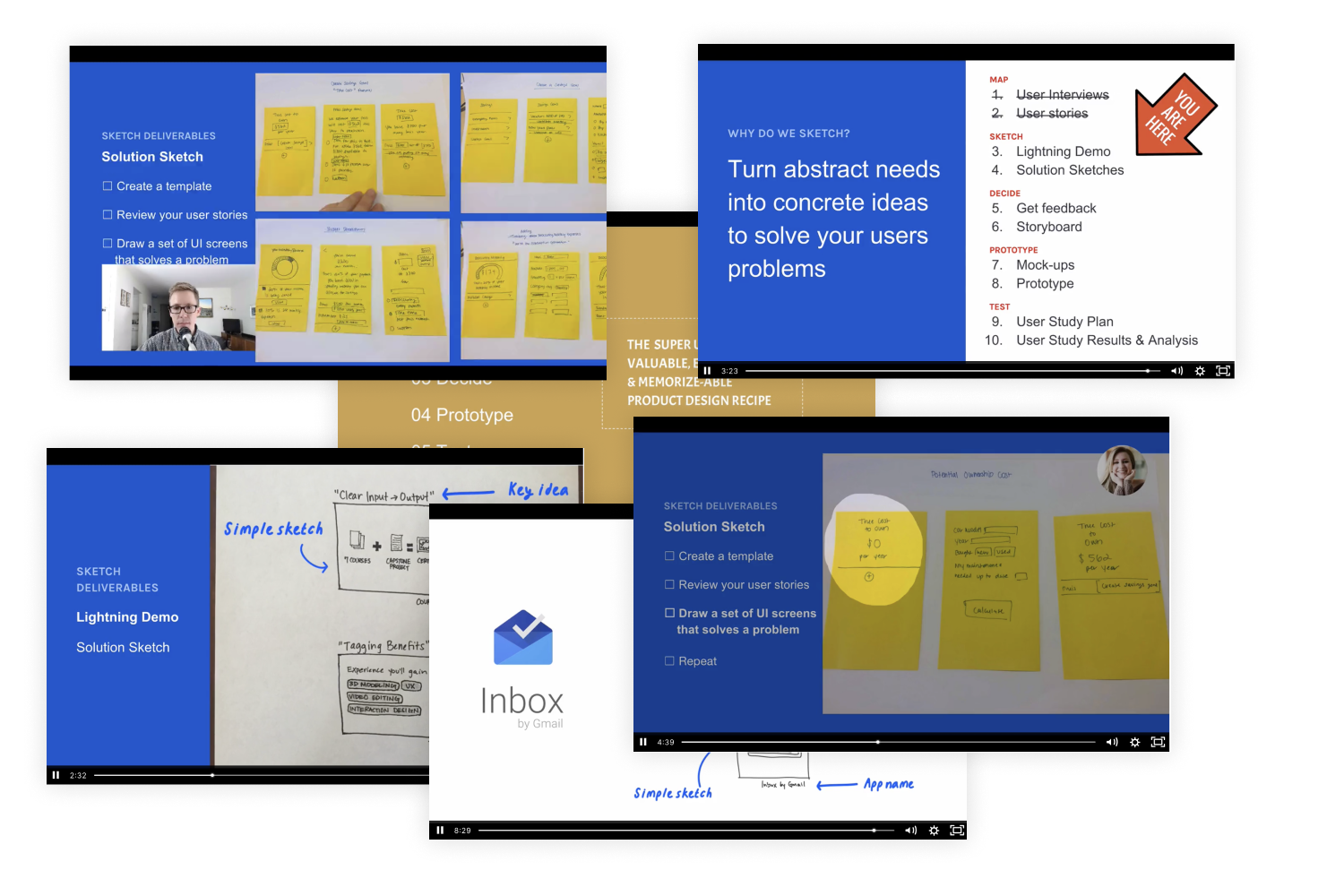
STAGE 2
Sketch
Take your problems, pains, and research to come up with solutions
You will learn..
- The real goal of sketching (hint: it’s not just to draw UI screens)
- How to use the simplest, most effective tools for sketching so you never have to think about them again
- How to write better and why writing is one of your most powerful and underrated skills
You will make...
- Lightning Demos (competitive analysis)
- Solutions Sketches

STAGE 3
Decide
Turn your best solutions into a step-by-step plan for your prototype
You will learn..
- How to make design decisions when you don’t know which direction to go
- Practice effective presentation skills using Google Slides
- How to get your team to vote fairly and as unbiased as possible when reviewing ideas
- The best words to use for critiquing others’ work and how to properly ask for feedback
- How to be a team leader by being able to ask your team members to work together and help you make design decisions
- A new method for getting everyone to agree and move forward quickly by collaboratively “storyboarding the Golden Path”
You will make...
- A clear list of feedback
- A Storyboard of your winning ideas

STAGE 4
Prototype
Get feedback from people before building the damn thing
You will learn..
- My tools for prototyping.. I’ve done hours of research, interviews, and experimentation to arrive at this very specific set of simple tools
- Understand how to design the simplest possible MVP (minimum-viable product)
- Which type of prototype to use (paper, low-fidelity wireframes, high-fidelity mock-ups), and when to use each one
- How to quickly create mock-ups and prototypes even when you have no visual design background
- My secret weapon for mocking-up the MVP design lightning- fast
- How to navigate design Pattern Libraries like Material Design to reference for the rest of your design career, and design the first version of your app super fast and accurately.
- How to talk to a developer, and confidently be able to talk about important UI elements like a “Table View” and a “Segmented Control”
- Learn the absolute best way to share your design with a developer, so they understand exactly what you mean and there’s less back-and-forth. They won’t believe how real it looks and feels.
You will make...
- A useful, useable, functional Prototype
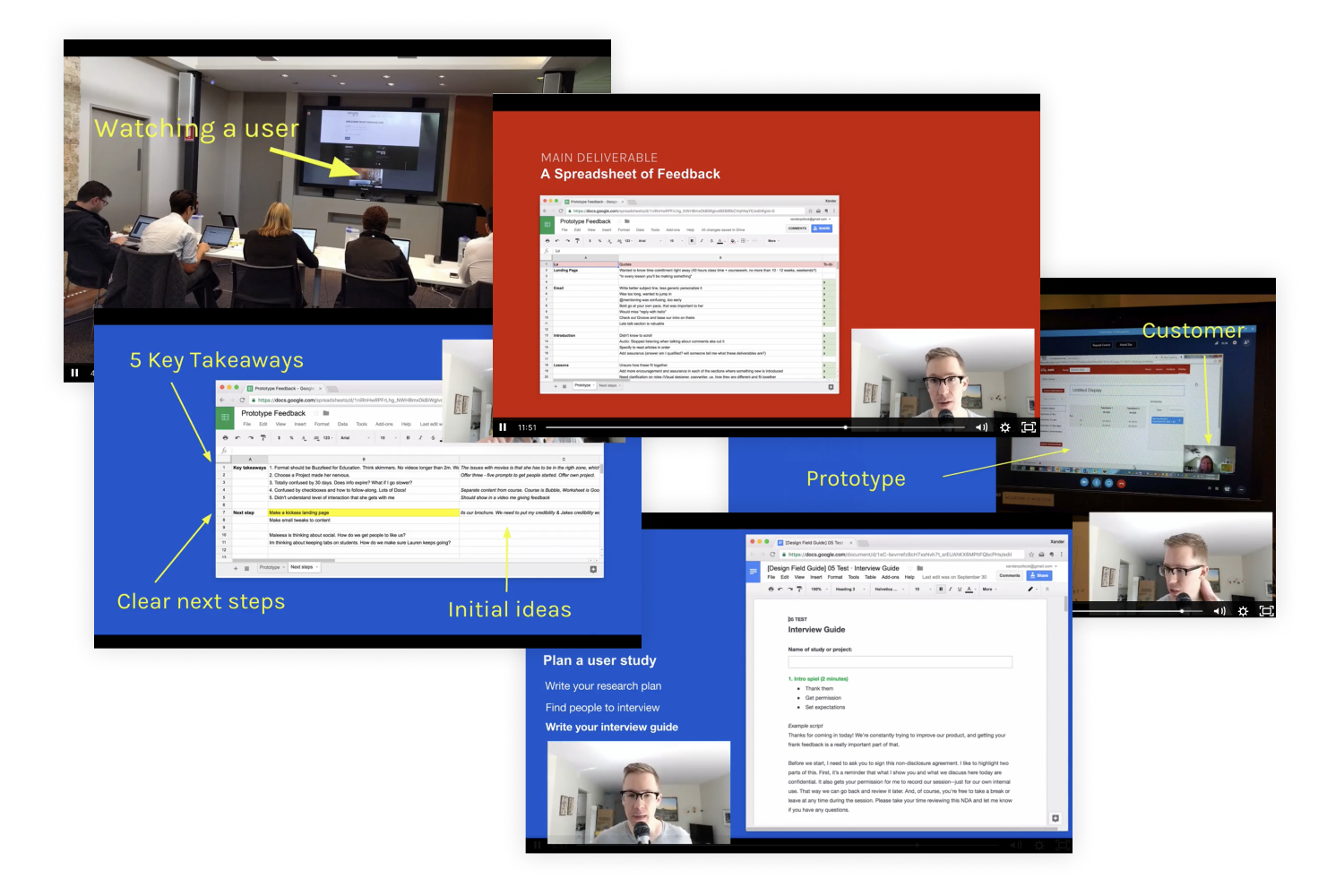
STAGE 5
Test
You will learn..
- Why user testing is critical to any business’ success, but especially software.
- How to run user studies to actually test your design with real users.
- Why 5 is the perfect magic number of users you need to interview.
- The software and hardware you’ll need to run your own user studies.
- What to expect when user testing.
- How to built a directory of organized and clear feedback on your designs to show product managers, engineers and others that show you how to move forward.
You will make...
- a user study plan & guide
- a user study summary including a useful spreadsheet of feedback
So that’s the foundation, but this training is more than just a video course…
- The entire Product Design Pro course (5 modules with over 20 video lessons)
- Meticulous step-by-step instructions and templates for all 8 deliverables you will learn & practice making
- Personal feedback on every project you complete
- Weekly live Q&A video chat office hours sessions you can attend where I’ll talk with students about their progress and projects
- I’ll be there if you need to talk before an interview.
- I’ll encourage you when you’re feeling unmotivated.
- I will go hard on you, holding you accountable and pushing you to become your best.
- I’ll give you valuable feedback on your work and set you on the right track to start working as a designer. You’ll get feedback from me within a few days of each work submission and to talk through your process and what to think about going forward.
100% Money Back Guarantee
Satisfaction Is Guaranteed. If you give my training an honest try, come to my office hours sessions, ask for help from the community, and are still not satisfied, tell me and I'll give you your money back.
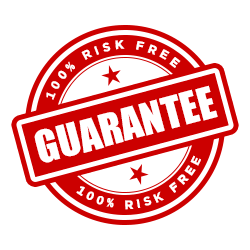
Will this work for me?
What if I'm not currently a designer?
Do I need to have a background in graphic design?
Do I need to learn how to code?
Will you help me get a job?
How much time will it take me to get through the course?
How much feedback do I get?
Why is the price cheap compared to a bootcamp?
What happens if I get stuck?
How long will I have access?
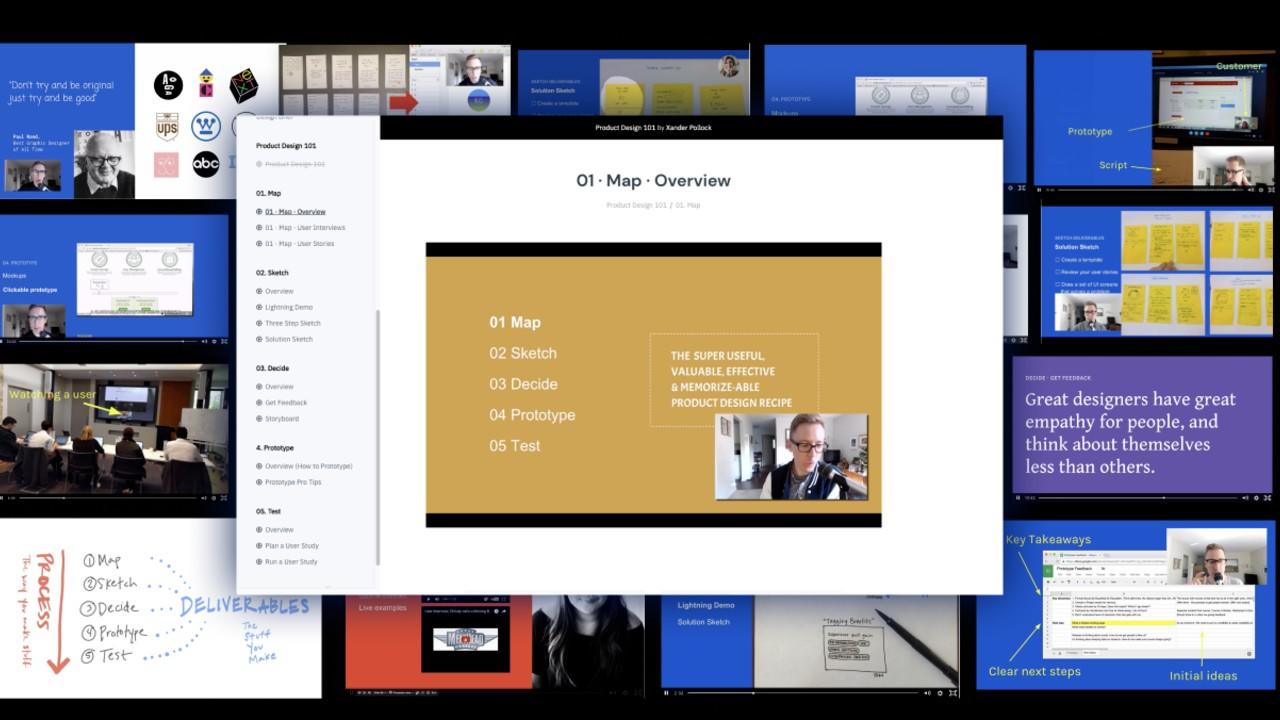
Get Just the Online Course
If you want the guides, videos, and checklists you can grab that here. If you decide you want to upgrade later, you can do that. I'll subtract the price you already paid for the guides when you are ready for coaching.
















